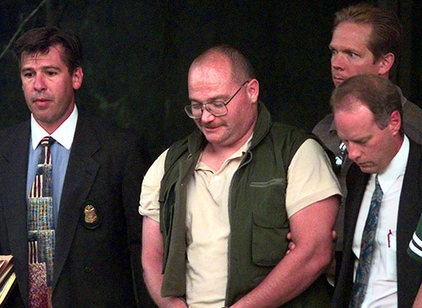MEDIA INTEREST in Buford Furrow's Los Angeles atrocity has been massive. His Aug. 10 assault on a Jewish community center in Los Angeles — which left five people wounded, three of them young boys — was a national story from the moment it broke. Scores of newspapers and television stations rushed reporters to the scene. Countless articles and editorials have been written about it. Every angle of the story has been explored, from Furrow's mental health history to the impact the attacks have had on other Jewish facilities nationwide.
 White supremacist Buford Furrow was charged with attempting to murder five people at a Jewish community center's summer camp. |
Perhaps not coincidentally, Furrow's rampage has also served to advance two causes that are popular with much of the media and with the liberal elite they so often reflect.
One, of course, is gun control. Furrow fired 70 rounds from an Uzi submachine gun at the community center, then used a Glock pistol one hour later to kill Joseph Ileto, a mail carrier. A Toyota he hijacked and then abandoned was found with seven guns and a stockpile of ammunition. Coming as it did after a string of highly publicized shootings, Furrow's savagery was held out as further proof that the freedom to acquire guns must be curbed.
"There are 192 million privately owned firearms in the United States," began The New York Times editorial on the events in Los Angeles. It went on to ask how many more such calamities it would take before Congress "stops babbling about the right to arms and does something serious about gun control." Innumerable media voices echoed the sentiment.
Furrow's horrifying attack was also offered as evidence that Congress ought to pass a sweeping "hate crime" law, the better to prosecute violent criminals who target minorities. In this case, the criminal was a neo-Nazi who ranted about Jews and blacks. When he turned himself in, police said, he explained that "he was concerned about the decline of the white race and wanted to send a message to America by killing Jews." He characterized his encounter with Ileto, a Filipino-American, as an unplanned "target of opportunity" to kill a nonwhite.
No federal hate crime law is needed to punish Furrow; everything he did is already illegal in California and prosecutors are sure to seek a harsh punishment. Still, it has become politically correct to demand a hate crime statute any time a bigot commits a heinous assault. On Aug. 12, President Clinton called for a new federal law as a matter of "common sense." Plenty of media voices have called for the same thing.
No apology is necessary for paying attention when an evildoer opens fire on a group of children. But would the media be quite as interested in Buford Furrow if he wasn't, by their lights, a poster boy for gun control and hate-crime laws?
Suppose, for instance, that the kids he tried to kill weren't in a Jewish institution but in a nonsectarian day-care center. Suppose he went after them not with an Uzi but with some other lethal weapon — a 300-horsepower automobile, say. Absent the gun control and hate-crime hooks, would the press have covered his monstrous crime so avidly?
We don't have to suppose. Less than four months ago, just such an enormity took place. The media scarcely blinked.
On May 3, Steven Abrams drove past the Southcoast Early Childhood Learning Center in Costa Mesa, Calif., where 40 small children were frolicking noisily in the playground. Deciding, as he later told police, "to execute those children," he pulled a U-turn, headed back toward the playground, and floored the accelerator. The car — a 1967 Cadillac sedan — tore through the chain-link fence, sent the jungle-gym flying, and plowed into the crowd of children. It stopped only when it ran into a tree.
Abrams was unhurt. But Sierra Soto, a 4-year-old who loved to dance ballet and play with her pet bunny Butterscotch, was dead, her body so mangled that the paramedics wouldn't let her mother see her. Brandon Wiener, a 3-year-old whose first word had been "vacuum" and who was never without his favorite teddy bear, was still alive when they got the car off him, but died that night in the hospital. Five-year-old Victoria Sherman suffered a fractured skull and a shattered pelvis. Nicholas McHardy, 2, was also badly injured. Two other children were hurt, and a teacher's aide was treated for multiple lacerations and cuts.
Two dead, five injured — Abrams's violence was far more grisly than Furrow's, and led to a grimmer body count. The sheer horror of the crime, if nothing else, should have attracted frenzied media attention. But it didn't involve guns, and it wasn't fueled by racial or ethnic bigotry, so it attracted almost none.
On May 5, many papers around the country ran an Associated Press story on the Costa Mesa massacre. Perhaps half a dozen ran a follow-up, also from the AP, on May 9.
And that was it. No drumbeat of daily coverage, no flood of editorials and opinion columns, no army of reporters flying out to see for themselves. The story was fully reported in California. It was virtually ignored everywhere else.
Does a homicidal attack on toddlers only make it to the front page when the killer uses a gun? Is attempted mass murder only newsworthy when the victims belong to an official minority group? Perhaps the nation's editors and producers have a sound journalistic reason for paying so much attention to Buford Furrow when they had paid so little to Steven Abrams. But none comes to mind.
Jeff Jacoby is a columnist for The Boston Globe.
-- ## --
Follow Jeff Jacoby on X (aka Twitter).
Discuss his columns on Facebook.
Want to read more? Sign up for "Arguable," Jeff Jacoby's free weekly email newsletter.

